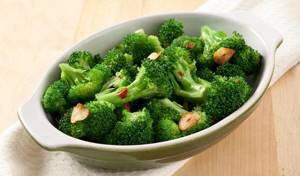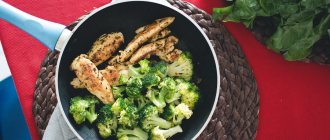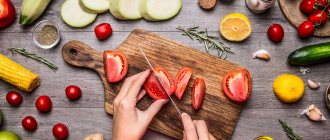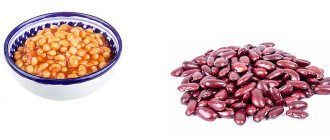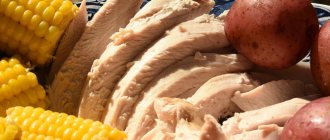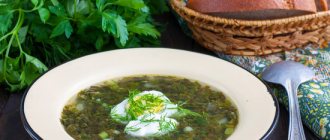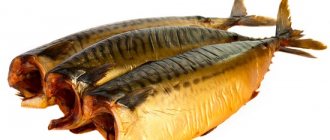03/29/2015 / Vegetables and herbs
| Boiled broccoli, BZHU and calorie content per 100 g of product | |||
| Calorie content 27 kcal | Proteins 3.0 g | Fat 0.4 g | Carbohydrates 4.0 g |
Broccoli is one of the healthiest dietary foods. The birthplace of this vegetable crop is in Italy, so broccoli is often used in Mediterranean dishes. Like cauliflower, broccoli has a tree-like structure, as evidenced by its Latin name broccolo - “scion”.
How many calories does it contain?
Swimming (25 m/min)
The calorie content of fresh asparagus cabbage is about 35 kilocalories per 100 grams of product. This is quite a bit, so broccoli can be consumed without restrictions on a diet, provided that there is not a lot of fat present during the cooking process. The vegetable can be consumed in almost any quantity, of course, if you do not have stomach problems.
When preparing this vegetable, take into account the fact that the more it is subjected to heat treatment, the more vitamins and nutrients are lost. The healthiest way to steam or stew broccoli is by adding a minimum of water. The optimal duration of the cooking process is 5 minutes. And when cooked in a microwave oven, the vegetable will lose all its value and benefits, so avoid this cooking method.
If you want to eat low-calorie and at the same time healthy food, pay attention to the additional ingredients for preparing this vegetable. For example, broccoli fried in oil with breadcrumbs will have the highest possible calorie content. The taste will be excellent, but there can be no question of diet here. And if you stew broccoli with sour cream, the dish will turn out to be of medium calorie content and will be suitable for those who have stomach problems.
The calorie content of fried broccoli is about 46-60 kcal per 100 g of product. A hearty and savory dish, as well as an excellent side dish - fried broccoli with garlic. To prepare it, wash the asparagus cabbage and boil for a couple of minutes. In a heated minimum amount of vegetable oil, fry a few crushed cloves of garlic until it browns. At the end, add the cabbage inflorescences and heat over medium heat for a couple more minutes.
Fresh broccoli has a low calorie content - 35 kcal per 100 g. If you want to eat this vegetable raw, rinse the asparagus cabbage, pour over boiling water, then pour in olive oil, salt and pepper. You can add any fresh vegetables to your taste.
A low-calorie and at the same time aromatic and tasty option is oven-baked broccoli, the calorie content of which will be only about 50 kcal per 100 g. When baking, use the secret of chefs, which is used in restaurants: it is worth sprinkling the cabbage with lemon juice, white wine or grape vinegar, and then cover with foil. A temperature of 200 degrees is suitable for baking.
You can also pour the eggs over the vegetables to create a delicious crust. For this you will need 250 g of asparagus cabbage, 1 carrot, 1 onion, 5 eggs, salt, basil and any vegetable oil. Place broccoli florets boiled for a couple of minutes in an oiled container. Sprinkle chopped onions and carrots on top of the cabbage.
Stewed broccoli is suitable for those who are on a diet, since its calorie content is only about 37-40 kcal per 100 g. A simple recipe for stewed asparagus cabbage is as follows. Onions and carrots are sautéed in a minimal amount of vegetable oil, broccoli florets and a little water are added to them. Simmer the vegetables over low heat for about 20 minutes, seasoning with salt and pepper to taste.
Steamed asparagus cabbage is the healthiest and lowest in calories, it contains only 27-28 kcal per 100 g. If, during cooking, water takes away some of the vitamins from the vegetable, then the steam penetrates into the core and completely preserves the taste, aroma of broccoli and all the beneficial properties. Steaming vegetables will preserve the maximum amount of vitamins, so be sure to adopt this cooking method.
To determine if the broccoli is ready, simply pierce it with a fork - if it goes in and out easily, it's time to serve the cabbage. And so that the cabbage does not taste completely bland, salt it, pepper it or add dry chopped garlic. If you are not afraid of ruining the figure, you can also add a few pieces of butter, which should melt while the cabbage is still hot.
If you want to surprise your guests with a delicious and unusual dish, try a simple recipe for broccoli in batter. Since the calorie content of this dish is high (about 95-100 kcal), it should be avoided by those who are on a diet or have stomach problems, since the broccoli undergoes a frying process. The washed cabbage is divided into inflorescences and boiled in salted water for several minutes. For the batter, mix a tablespoon of vegetable oil, a tablespoon of flour, 1 egg and add salt to taste.
Dip the inflorescences in thick batter and place in vegetable oil preheated in a frying pan. Fry the inflorescences evenly on each side and serve the finished dish to the table.
The idea of tracking calories in food is so widespread in the world that everyone has long known that the calorie content of any product can change depending on the cooking method. Those who don’t know yet can read our article on “how to learn to count calories for weight loss.”
And we have prepared a special table for you, which shows the calorie content of steamed, boiled, fried and battered broccoli per 100 grams.
| Boiled | 29 |
| Fried | 45 |
| For a couple | 27,9 |
| Breaded | 98,3 |
Having carefully examined the table, you can conclude that broccoli in batter has the highest calorie content, and this is not surprising. After all, the vegetable is not just fried in oil, but also with the addition of an egg, which is why this cooking option is least suitable for those who want to lose weight.
Broccoli is a well-balanced and very healthy food that contains many beneficial nutrients needed by the human body. It contains the following substances:
- proteins and essential amino acids;
- popular omega-3 unsaturated fatty acids;
- this cabbage contains a lot of fiber, which promotes effective weight loss and cleansing of the body;
- Broccoli contains calories in small quantities, approximately 34 Kcal per 100 grams;
- The caloric content of broccoli is proteins - 2.82 g, fats - 0.37 g, carbohydrates - 6.64 g, dietary fiber - 2.6 g.
Application
Broccoli is a capricious vegetable; if you overcook it a little, all the benefits will be lost. Broccoli is either steamed for a few minutes or placed in boiling salted water for 3-5 minutes. At the same time, the broccoli inflorescences should retain a bright green color.
If you separate broccoli into small florets before cooking and leave for 5 minutes, the antioxidant properties of the vegetable will increase. The chopped inflorescences produce the enzyme myrosinase, which enhances the effects of vitamin C and promotes the production of sulfur compounds that are effective in fighting cancer.
Market Analytics
- Black Lives Matter movement: reaction and consequences for the beauty industry
- COVID-19 is changing the rules of the game in the cosmetics market
- Beauty of the future: cosmetic innovations 2021
Convenient search for beauty salons on our website
Beauty salons in Moscow Beauty salons in St. Petersburg Beauty salons in Ekaterinburg Beauty salons in Novosibirsk
Latest blog posts on our website
- Naturecream / Tremella Extract - Snow Mushroom Detox for Skin
- Prostye-sovety / How to visually enlarge your lips with makeup
- Naturecream / Apricot kernel oil for face
- Naturecream / MATRIXYL3000 - the best skin elasticity stimulator
- Naturecream / SPF in Natural Oils
- Naturecream / Geranium (Pelargonium) oil for skin health and beauty
- Prostye-sovety / Save on a beauty salon: procedures that can be done at home
- Naturecream / Growth Factor - brings back youth?
- Oksana-Lezina / 3 effective abdominal exercises from a fitness instructor for beginners
- Prostye-sovety / Making perfect curls at home
Latest forum topics on our website
- Natalya / How to properly make a gelatin mask?
- Mrs._Smith / Badly sunburned! What to do?((
- Ice / Is it necessary to combine fitness classes with a diet?
- Antonova / What can be used for hair loss?
- Radio operatorKat / Who was on a protein diet?
Other articles in this section
| Romaine lettuce Romaine lettuce, or romaine, has been cultivated since ancient times. Also sometimes called cos salad. Its homeland is in the eastern Mediterranean. From the 5th century n. e. Romaine lettuce began to be grown in China. There it was considered a symbol of good luck. Romano was served on the table on holidays - New Year, birthdays. It differs from lettuce in having larger, dark green leaves with a crunchy texture. |
| Elecampane According to ancient Greek legend, elecampane owes its Latin name (Inula Helenium) to Helen of Troy. Where her tears fell, this medicinal plant grew. The ancient Greeks and Romans considered elecampane a panacea for many diseases. The plant reaches a height of more than a meter, the flowers resemble sunflowers, but are smaller in size. Grows in Europe, Asia, North America. |
| Dandelion Dandelion officinalis belongs to the Asteraceae family. Since ancient times, dandelion has been a popular plant that can diversify the diet. Almost all parts of the plant are used for culinary and medicinal purposes - leaves, flowers and roots along with the milky juice. Central Asia is considered the birthplace of dandelion. This hardy plant grows in temperate and subtropical climates in fields and meadows. |
| Radishes Radishes belong to the cruciferous family. This small, bright pink root vegetable begins to bear fruit in the spring. Radishes are early-ripening vegetables; several harvests can be harvested in one season. It has an easily recognizable pungent taste. |
| Sweet potatoes (yams) Unlike regular potatoes, sweet potatoes are not a tuber, but a root. Its homeland is also Central and South America, where the local population has been growing this vegetable crop for more than 10 thousand years. Sweet potatoes also came to Europe thanks to H. Columbus. In the 16th century Spanish and Portuguese travelers spread this culture to the Philippines and Africa. Currently, the largest supplier of sweet potatoes is China, where 80 million tons of sweet potatoes are produced annually. |
| White beans White beans belong to the type Common beans. The homeland of beans is Peru, from where the plant spread throughout South and Central America. In the 15th century Spanish travelers brought beans from the New World to Europe. White beans, like other legumes, have exceptional nutritional value and are especially beneficial for vegetarians. |
| Nettle Nettle is known throughout the world for its “stinging” leaves. The leaves and stem of nettle are covered with hairs, the chemical in which causes irritation when in contact with bare skin. |
| Rhubarb Rhubarb is a vegetable plant of the buckwheat family. Thick red stems end in large triangular leaves, rhubarb grows for 10-15 years. Siberia is considered its homeland; it grows in temperate climates in Russia, Europe and North America. Only the stems of the plant are eaten, since the leaves contain a very high concentration of oxalic acid, so they are considered poisonous. Rhubarb stems have an easily recognizable sweet and sour taste. |
| Fennel Crunchy and slightly sweet, fennel plays an important role in the national cuisine of European countries, especially France and Italy. This plant has been grown since ancient times and is even mentioned in ancient Greek myths. According to legend, fennel is not only closely associated with Dionysus, the god of wine and fun, but with its help people learned about fire. On a fennel stalk, people were given an ember stolen from the gods. Fennel's aromatic taste is reminiscent of anise, with which it is often confused. Fennel is the closest relative of dill. |
| Savoy cabbage Savoy cabbage is more similar to white cabbage, only the leaves of white cabbage have a smooth surface, while Savoy cabbage has a corrugated surface. Savoy cabbage has a more delicate taste and aroma; the leaves do not have thick, coarse veins, like white cabbage. Like other cruciferous vegetables, it contains many nutrients, especially glucosinolates. The name of this type of cabbage comes from the Italian county of Savoy, where it was first grown. |
Broccoli
This dietary vegetable came to us from afar. A fortified vegetable native to the Mediterranean and South Asia . In these countries, people have been eating broccoli every day for centuries in any form:
Boiled broccoli has the most pleasant taste. This cabbage is very tasty and filling. It is an annual vegetable plant. Since it is a subspecies of cauliflower, the same parts of the vegetable are suitable for food as in cauliflower.
There are several types of broccoli. Olin is a head of cabbage with a thick umbrella-shaped stem and green inflorescences tightly adjacent to each other at the end. There is also asparagus broccoli , which has many thin stems with small inflorescences. Another type of purple cabbage is grown.
This cabbage makes tasty and healthy soups, stews, and is also added to vegetable salads and consumed raw. It is usually served with mayonnaise, sauce, sour cream, ground breadcrumbs, and butter.
Calorie content of broccoli per 100 grams
This type of cabbage is a real dietary product. Due to its low calorie content and many beneficial properties, it is included in the menu of most diets. The calorie content of the vegetable will depend on the cooking method. The nutritional value of fresh broccoli is 34 calories per 100 grams, of which:
- proteins – 5.0 g;
- fats – 0.4 g;
- carbohydrates – 5.2 g.
Such low caloric content of raw vegetables will not harm the figure, but will only contribute to weight loss and improvement of the whole body.
Most often, broccoli is consumed boiled, so the question immediately arises, how many calories are in boiled cabbage? The calorie content of boiled broccoli is even lower, only 28 units , of which:
- proteins – 3.0 g;
- fats – 0.4 g;
- carbohydrates – 5.2 g.
With such a low calorie content, the vegetable contains a large amount of vegetable protein and fat. The ratio of BZHU by weight will be as follows:
The calorie content of a fried dietary vegetable per 100 grams will be significantly higher – 46 calories. The vegetable absorbs oil and other ingredients during cooking. To reduce the calorie content, cabbage can be steamed and then the number of calories will be only 27 units. 100 grams of stewed cabbage will contain slightly more calories – 37 units.
If you use broccoli for dietary purposes, it is better to boil it , steam it or add it raw to salads. The low calorie content of this healthy vegetable will help you lose extra pounds.
Composition and benefits of green vegetables
Broccoli is very rich in its composition of nutrients. It is a nutritionally balanced product. It contains a lot of fiber, which is very important for dietary nutrition. Broccoli also contains the popular Omega-3 unsaturated fats, amino acids that are important in cleansing the body and losing weight. Cabbage is an important food in many popular diets.
Broccoli is an excellent supplier of vital vitamins and minerals:
- A, C, K, PP, U;
- iron and sodium:
- potassium and phosphorus:
- chrome and copper;
- manganese and boron:
- calcium and magnesium.
In terms of vitamin C content, it surpasses citrus fruits and provides even more than the body needs per day. Since it is a subspecies of cauliflower, it contains many of the same substances, but several times more. It contains twice as much mineral salts and vegetable protein as regular cauliflower.
According to doctors, the daily intake should be 200 grams. This will serve as an effective preventive food product for many health problems:
- will reduce the risk of cancer, heart and vascular disease;
- strengthens the immune system and nervous system;
- improves the functioning of the digestive system;
- will be beneficial for diabetes;
- improves the condition of hair, nails and skin;
Doctors and nutritionists recommend including broccoli in your daily diet for the purpose of improving your health.
Cabbage has contraindications . It is undesirable to use it if you have high stomach acidity or pancreatic disease. If you want to include it in your regular diet, it is better to make sure there are no contraindications.
If there are no contraindications, the dietary product can prolong youth, help you lose excess weight and improve your health. This healthy vegetable can be prepared in different ways and add variety to the menu for the whole family without harm to health.
How it is used in dietetics and for weight loss
For a long time now, nutritionists from all over the world have been promoting this green cabbage as a source of strength, energy and an excellent way to lose weight. The point is not only the low energy value of cabbage, but also the content of coarse dietary fiber, which helps reduce appetite and cleanse the intestines. Scientists have found that cabbage contains a large amount of amino acids, proteins, fiber and antioxidants, which are responsible for youth and beauty, and also prevent active cell aging.
Some nutritionists argue that this type of cabbage is a negative-calorie vegetable, which means that the body spends more energy digesting it than it takes in. Nutritionists recommend periodically arranging fasting days with broccoli.

By doing this once a week, you can not only get rid of extra pounds, but also significantly improve your overall health.
Broccoli - calorie content 34 kcal/100 grams - ideal product
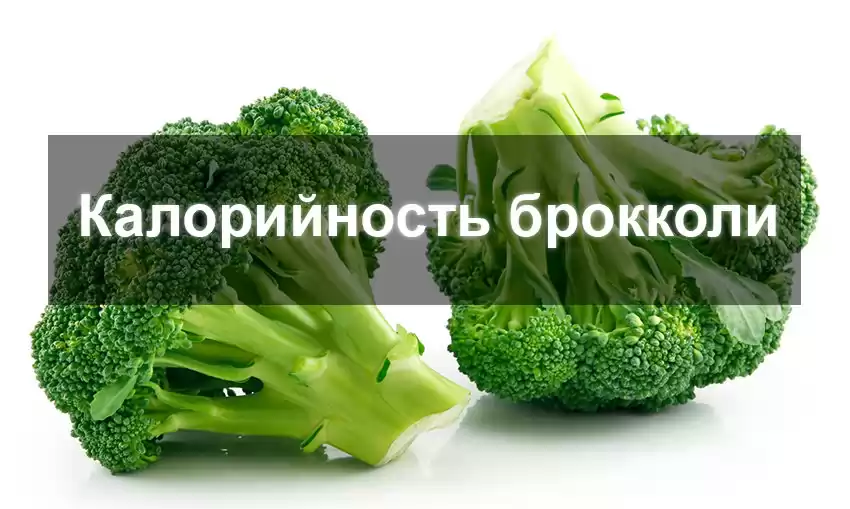
Calorie content of broccoli is 34 calories per 100 grams of product . Broccoli is a must-have product for people on a diet. Broccoli has virtually no fat, its content per 100 grams is only 0.4 grams, about 2.8 proteins and 7 grams of carbohydrates.
For many, at first glance, broccoli is an unremarkable product that is not at all necessary to eat. Other people have a standard stereotype in their heads that this product is only for people who want to get in shape. Is this what this plant hides inside itself?
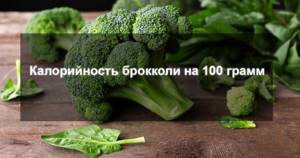
Nutritional value and chemical composition
A lot has already been said about how useful this green vegetable is, but let's figure out what makes cabbage so valuable. To do this, you need to pay attention to the nutritional value and chemical composition of this green vegetable.
Nutritional value of broccoli per 100 grams:
| Quantity | Norm |
in a day
Broccoli has in its chemical composition a huge number of different vitamins, proteins and fiber, as well as many different minerals. Scientists have found that broccoli contains calcium, potassium, iodine, a lot of chromium, iron, fluorine, and manganese, magnesium and iodine were also found.
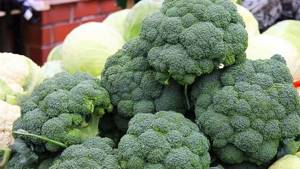
In addition, the vegetable is rich in protein and beneficial amino acids, which is why it is often compared with various types of meat in terms of its beneficial qualities.
Additionally, it can be noted that the vegetable contains a large amount of phytoncides, which have disinfecting and bactericidal properties.
Beneficial properties of broccoli
Speaking about the beneficial properties, one cannot fail to emphasize the record content of vitamin C per 100 grams - 89.2 mg, sodium per 100 grams - 33 mg, which affects the state of water-salt balance in the human body, and potassium (316 mg), which supports the functioning of the heart and nervous system. Broccoli also contains a whole range of vitamins, microelements and minerals such as: calcium, zinc, phosphorus, magnesium, manganese, sulfur, fiber, B1, B2, B5, B6, PP, E, K, provitamin A and is an excellent supplier of beta carotene.

Micro- and macroelements in Broccoli, boiled, without salt
Broccoli, chopped, frozen, boiled, with salt contains the following elements: Mono- and disaccharides, SFA - Saturated fatty acids, Ash, Water, Dietary fiber, Sodium, Potassium, Phosphorus, Magnesium, Calcium, Copper, Manganese, Selenium, Zinc, Iron.
| Micro and macro element | Meaning |
| Mono- and disaccharides, g. | 1,47 |
| SFA - Saturated fatty acids, g. | 0,018 |
| Zola, Mr. | 0,71 |
| Water, city | 90,72 |
| Dietary fiber, g. | 3 |
| Sodium, mg | 260 |
| Potassium, mg | 142 |
| Phosphorus, mg | 49 |
| Magnesium, mg | 13 |
| Calcium, mg | 33 |
| Copper, µg | 34 |
| Manganese, mg | 0,223 |
| Selenium, mcg | 0,7 |
| Zinc, mg | 0,28 |
| Iron, mg | 0,61 |
Broccoli, chopped, frozen, boiled, without salt, contains the following elements: Mono- and disaccharides, SFA - Saturated fatty acids, Ash, Water, Dietary fiber, Sodium, Potassium, Phosphorus, Magnesium, Calcium, Copper, Manganese, Selenium, Zinc, Iron.
| Micro and macro element | Meaning |
| Mono- and disaccharides, g. | 1,47 |
| SFA - Saturated fatty acids, g. | 0,018 |
| Zola, Mr. | 0,71 |
| Water, city | 90,72 |
| Dietary fiber, g. | 3 |
| Sodium, mg | 11 |
| Potassium, mg | 142 |
| Phosphorus, mg | 49 |
| Magnesium, mg | 13 |
| Calcium, mg | 33 |
| Copper, µg | 34 |
| Manganese, mg | 0,223 |
| Selenium, mcg | 0,7 |
| Zinc, mg | 0,28 |
| Iron, mg | 0,61 |
Broccoli, boiled, without salt, contains the following elements: Mono- and disaccharides, SFA - Saturated fatty acids, Ash, Water, Dietary fiber, Sodium, Potassium, Phosphorus, Magnesium, Calcium, Copper, Manganese, Fluorine, Selenium, Zinc, Iron.
| Micro and macro element | Meaning |
| Mono- and disaccharides, g. | 1,39 |
| SFA - Saturated fatty acids, g. | 0,079 |
| Zola, Mr. | 0,77 |
| Water, city | 89,25 |
| Dietary fiber, g. | 3,3 |
| Sodium, mg | 41 |
| Potassium, mg | 293 |
| Phosphorus, mg | 67 |
| Magnesium, mg | 21 |
| Calcium, mg | 40 |
| Copper, µg | 61 |
| Manganese, mg | 0,194 |
| Fluorine, mcg | 4 |
| Selenium, mcg | 1,6 |
| Zinc, mg | 0,45 |
| Iron, mg | 0,67 |
Calorie content of broccoli per 100 grams of product in various types
In the table of caloric content of broccoli per 100 grams of product, you can easily create a diet for yourself with this product. And understand in what form it is best for you to prepare it.
calorie content of boiled broccoli – 27 kcal/100 grams
calorie content of steamed broccoli – 27 kcal/100 grams
calorie content of broccoli puree soup – 85 kcal/100 grams
fried broccoli calorie content – 28 kcal/100 grams
broccoli in the oven calorie content – 80.5 kcal/100 grams
calorie content of broccoli with egg – 72.5 kcal/100 grams
broccoli with cheese calorie content – 164 kcal/100 grams
calorie content of baked broccoli – 23 kcal/100 grams
calorie content of frozen broccoli – 23 kcal/100 grams
broccoli in sour cream calorie content – 92.5 kcal/100 grams
calorie content of broccoli boiled with salt – 35 kcal/100 grams
fried broccoli calorie content – 28 kcal/100 grams
Stewed broccoli calorie content – 37 kcal/100 grams
calorie content of raw broccoli – 34 kcal/100 grams
steamed broccoli calorie content in a slow cooker – 28 kcal/100 grams
calorie content of fresh broccoli – 28 kcal/100 grams
We can say with complete confidence about the unconditional benefits of this plant on the human body.
Vitamins in Broccoli, boiled, without salt
Broccoli, chopped, frozen, boiled, with salt contains the following vitamins: Mono- and disaccharides, SFA - Saturated fatty acids, Ash, Water, Dietary fiber, Sodium, Potassium, Phosphorus, Magnesium, Calcium, Copper, Manganese, Selenium, Zinc, Iron.
| Vitamin | Meaning |
| Vitamin B1 (thiamine), mg | 0,055 |
| Vitamin B2 (riboflavin), mg | 0,081 |
| Vitamin B3 (pantothenic), mg | 0,274 |
| Vitamin B6 (pyridoxine), mg | 0,13 |
| Vitamin B9 (folic), mcg | 56 |
| Vitamin C, mg | 40,1 |
| Vitamin E (TE), mg | 1,32 |
| Vitamin K (phylloquinone), mcg | 88,1 |
| Vitamin PP (Niacin equivalent), mg | 0,458 |
| Choline, mg | 16,2 |
| Vitamin A (VE), mcg | 51 |
| Beta-carotene, mg | 0,597 |
| Product | Kcal | Proteins, g | Fats, g | Angle, g |
| Broccoli | 34 | 2,82 | 0,37 | 6,64 |
| Cooked Broccoli (no fat) | 35 | 2,37 | 0,41 | 7,14 |
| Broccoli Raab | 22 | 3,17 | 0,49 | 2,85 |
| Broccoli inflorescences | 28 | 2,98 | 0,35 | 5,24 |
| Chinese Broccoli (Boiled) | 22 | 1,14 | 0,72 | 3,81 |
| Pickled broccoli | 35 | 2,38 | 0,41 | 3,88 |
| Broccoli, boiled, no salt | 35 | 2,38 | 0,41 | 3,88 |
| Broccoli, boiled, with salt | 35 | 2,38 | 0,41 | 3,88 |
| Broccoli, branches, frozen, boiled, with salt | 28 | 3,1 | 0,11 | 2,35 |
| Broccoli, leaves, raw | 28 | 2,98 | 0,35 | 5,24 |
| Broccoli, sprouts, frozen, boiled, no salt | 28 | 3,1 | 0,11 | 2,36 |
| Broccoli, sprouts, frozen, uncooked | 29 | 3,06 | 0,34 | 2,35 |
| Broccoli, chopped, frozen, boiled, no salt | 28 | 3,1 | 0,12 | 2,35 |
| Broccoli, chopped, frozen, boiled, with salt | 28 | 3,1 | 0,12 | 2,35 |
| Broccoli, chopped, frozen, uncooked | 26 | 2,81 | 0,29 | 1,78 |
| Broccoli, stem, raw | 28 | 2,98 | 0,35 | 5,24 |
| Broccoli, raw | 34 | 2,82 | 0,37 | 4,04 |
| Broccoli, color, raw | 28 | 2,98 | 0,35 | 5,24 |
| Chinese broccoli, cooked | 22 | 1,14 | 0,72 | 1,31 |
Broccoli, chopped, frozen, boiled, without salt, contains the following vitamins: Mono- and disaccharides, SFA - Saturated fatty acids, Ash, Water, Dietary fiber, Sodium, Potassium, Phosphorus, Magnesium, Calcium, Copper, Manganese, Selenium, Zinc, Iron.
Broccoli, boiled, without salt, contains the following vitamins: Mono- and disaccharides, SFA - Saturated fatty acids, Ash, Water, Dietary fiber, Sodium, Potassium, Phosphorus, Magnesium, Calcium, Copper, Manganese, Fluorine, Selenium, Zinc, Iron.
| Vitamin | Meaning |
| Vitamin B1 (thiamine), mg | 0,063 |
| Vitamin B2 (riboflavin), mg | 0,123 |
| Vitamin B3 (pantothenic), mg | 0,616 |
| Vitamin B6 (pyridoxine), mg | 0,2 |
| Vitamin B9 (folic), mcg | 108 |
| Vitamin C, mg | 64,9 |
| Vitamin E (TE), mg | 1,45 |
| Vitamin K (phylloquinone), mcg | 141,1 |
| Vitamin PP (Niacin equivalent), mg | 0,553 |
| Choline, mg | 40,1 |
| Vitamin A (VE), mcg | 77 |
| Beta-carotene, mg | 0,929 |
Cauliflower broccoli calories and sugar
Despite the fact that broccoli is quite low in calories, when you look at the composition of carbohydrates, you can see sugar. Yes, its quantity is not so significant, only 1.7 grams per 100 grams, but if you consider that the entire inflorescence weighs about 400-500 grams, and during the cooking process the volume of the product is reduced, respectively, the average portion will be 200-250 grams. Using the calculation method, 3.4-4.25 grams of sugar is 1 heaped teaspoon of sugar or approximately 16 kcal. Does this mean that, despite the benefits of broccoli, you should exclude it from your diet? Of course not! The fact is that the concentration of sugar in it is quite small, and to eat even 15 grams (a relatively acceptable norm for those losing weight) of sugar using this product, you will need a huge portion.
Popular dishes with this product
There are a huge number of ways to prepare this type of cabbage, which greatly simplifies and makes the process of losing weight more varied. It can be eaten as a separate side dish or added to various dishes to give it a more piquant taste.
We have collected for you 3 of the most popular broccoli recipes that you can easily prepare.
Casserole with broccoli, cheese and cauliflower
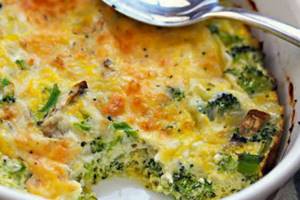
The casserole is a unique dish, because there is nothing easier than mixing several ingredients and placing everything in the oven. The combination of cauliflower, broccoli and cheese will be appreciated by adherents of proper nutrition, because it is not only tasty, but also low in calories, only 61 kcal per 100 grams.
Please note that the recipe makes 8 servings.
To prepare you will need:
| Ingredients | Quantity |
| Broccoli | 550 g |
| Cauliflower | 550 g |
| Egg | 2 pcs. |
| Leek | 1 PC. |
| bell pepper | 20 g |
| Tomato | 1 PC. |
| Cream 15% | 250 ml |
| Cheese | 100 g |
| Spinach | taste |
| Salt pepper | taste |
Cooking process:
- Cauliflower and broccoli must be disassembled into inflorescences, then pour boiling water for 15 minutes.
- Cut the leek into half rings and the bell pepper into cubes.
- Rub the tomatoes and mix with cream and eggs.
- Take out the cabbage and place it in a special form, distributing it evenly.
- Add chopped vegetables and spinach, then mix everything thoroughly.
- Add salt and pepper to taste, stir, and then pour the mixture with cream over everything.
- Grate the cheese and add to the casserole.
- Place in an oven preheated to 200 degrees for 25 minutes.
Broccoli negative calories
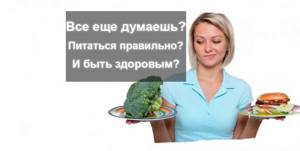
There is a myth about negative calories, which includes almost all vegetables and some fruits. This also includes broccoli. Let's sort it out in order. There is no negative calorie content, because absolutely any product has a calorie content. But the body can spend much more energy on digesting food than it contains. This is where the myth of “negative calories” comes from. As for the list of products, everything is purely individual (for example, weight, ratio of fat and muscle tissue). But you can help your body burn more calories with a little trick - chewing thoroughly. Since childhood, we have heard that food needs to be chewed carefully and slowly, but we don’t understand why. The secret is that the digestion process occurs regardless of the density of the food eaten, but the costs may vary. That is why the better the food is chewed, the better for the figure.
Benefit and taste
So, let's face it, boiled broccoli is low in calories, and therefore will not pose a threat to your figure. The taste of cabbage is delicate and versatile, and therefore broccoli will be an excellent side dish for meat, fish and offal dishes. The benefits of cabbage are invaluable, and its richness in vitamins C, PP, and K is impressive. Broccoli is full of ascorbic acid. According to this indicator, it is ahead of citrus fruits.
